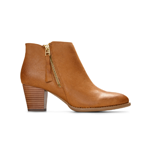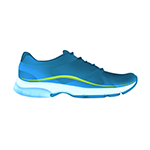
Overpronation vs. Underpronation

If the inside of your ankle tends to hurt when you walk, or you’re experiencing pain in your feet, legs, and hips, you may have come across the term “pronation.” Pronation refers to the natural landing movement your feet make with every step.1
The action absorbs shock from your body weight and distributes impact from the ground. On its own, pronation only refers to this landing movement and doesn’t imply anything is wrong. In other words, everyone pronates when they walk. Orthotics can be a great way to mitigate this issue.
Someone with neutral pronation has a healthy, natural gait that absorbs shock and keeps their ankles and legs aligned. However, when people ask “what is foot pronation?”, they’re often referring to overpronation vs underpronation. Read on for a breakdown of each runner’s condition, including potential causes and effects.
OVERPRONATION VS. UNDERPRONATION: WHAT’S THE DIFFERENCE?
Now that you know what pronation is, you’re probably wondering what it means to overpronate or underpronate. The podiatry enthusiasts at Vionic are here to answer all your questions on the topic. Let’s get started.
What Is Overpronation?
Overpronation is when the bottom of the foot splays (spread out) fully every time it touches the ground or floor.2 Among people who overpronate, the ankles usually rotate in and down at an angle, which pulls the underfoot entirely (or almost entirely) down. Those with flat feet and naturally low arches are more likely to have this condition, but nearly any foot type can experience it.
Effects of Overpronation
Since overpronating pulls on ligaments throughout the legs, knees, and hips, it can lead to other biomechanical issues. When the repetitive strain tugs on soft tissues, it often results in foot pain over time. The exaggerated rotation may inadvertently turn the medial tibial and cause medial tibial stress syndrome (shin splints).3
Additionally, the added weight and inward rotation often create uncomfortable friction on different pressure points throughout the feet. This can cause painful blisters, corns, or calluses.
Overpronation sometimes strains the big toe and second toe, as well, which can contribute to instability. This is one reason why those with foot pronation issues are more likely to suffer from injuries.
Overpronation can lead to various other conditions, too, like plantar fasciitis (one of the most common causes of heel pain), Achilles tendonitis, bunions, and patellofemoral pain syndrome (chronically inflamed kneecaps).4 Bunions are a common foot deformity that can occur from both overpronation and underpronation. Wondering what causes bunions and can bunions be reversed? The removal of bunions requires a surgical procedure to completely rid the bony protrusion. For those who opt out of surgery, Vionic offers some of the best sandals for bunions that are certain to provide the comfort and support your feet will thank you for.
What Is Underpronation?
Underpronation is when the feet roll outward with every step. Sometimes referred to as excess supination, it typically means the underside of the foot splays less than it should when it touches the ground. As a result, the body doesn’t distribute its weight evenly, and the feet don’t adequately absorb shock.
Those with naturally high arches are more likely to underpronate when they walk. However, virtually anyone can experience supination, even people with flat feet.
Effects of Underpronation
When all the pressure of walking is put on the outer edges of the feet and weakest toes, it can result in a number of problems. This added weight, when combined with inadequate shock absorption, creates an immense strain not only on the arches, toes, and ankles but also the calves, legs, and knees.
People who underpronate may experience plantar fasciitis or other types of heel pain, as well as iliotibial band syndrome (pain in the kneecap), Achilles tendonitis, lower back pain, bunions, calluses, blisters, and lateral peroneal tendonitis (inflamed, thickened tendons in the outer ankle).
Stress fractures can also occur as a result of underpronation.5 This type of overuse injury is characterized by small cracks in the bone and often appears in weight-bearing bones in the feet. Additionally, the imbalance caused by excessive supination can put an individual at a higher risk for injury.
HOW TO TELL IF YOU OVERPRONATE OR UNDERPRONATE
How do you know if you’re an underpronator or an overpronator? If you think you have one of these gait cycle issues, it’s probably best to see a podiatrist or orthopedist. However, a quick at-home test can also provide clues as to how you pronate.
The Wet Test
Also known as the Wet Test, all you’ll need for this simple analysis is a tub, bowl, or basin of water and a piece of cardboard large enough for both of your feet.6
First, fill the container with an inch or two of water. Next, dip your feet in so that the bottoms are entirely wet. Then remove your feet, give them a quick shake, and step onto the cardboard.
When you step off the cardboard, you should see a clear imprint of your feet. We recommend taking a picture before the water dries so you have plenty of time to interpret the results.
Neutral Pronation Footprint
If your pronation is neutral, your footprint will display a distinct connection between the ball of your foot and your heel. This ridge will be roughly half as wide as the overall width of your foot, indicating proper leg and ankle alignment, even weight distribution, and effective shock absorption.
Overpronation Footprint
If you overpronate, the imprint will display almost the entire bottom of your foot. A wide, continuous connection between the ball of the foot and the heel indicates that the inner ankle rolls inward and downward, which creates a full splay with every step.
Bear in mind that those with flat feet (fallen arches) may show a similar footprint. A Flat foot can make a person more likely to overpronate, but this isn’t always the case.
Underpronation Footprint
If you underpronate, your footprint will display a notably narrow connection between the heel and ball of the foot. This implies an overreliance on the outer edge of the foot while walking.
People with naturally high arches will show a similar imprint. As we mentioned, they’re more likely to underpronate, but a footprint alone can’t say for sure whether an individual struggles with supination.
WHAT ARE THE BEST SHOES FOR PRONATED FEET?
For how to correct overpronation and underpronation, adequate arch support and motion-control footbeds are ideal. Without this support and stability, the body may overcompensate by putting unnecessary weight on other areas of the foot.
Vionic is dedicated to designing orthotic footwear to help ease the discomforts of many foot-related ailments, including pronation issues. In addition to built-in arch support and motion-control orthotic insoles, our durable outsoles are designed to absorb traction and minimize pressure on your feet. For more information on sore feet causes, check out Vionic today.
Orthotic Inserts for Pronated Feet
We’re also proud to carry orthotics for pronated feet, which boast the same podiatrist-designed contouring as our footwear. You can use them to replace the factory inserts of virtually any other pair of closed-toe shoes.
Browse our collections for men and women today!
Sources:
- Jordi Lippe-McGraw. “The Beginner’s Guide to Pronation”. Healthline. Updated on March 8, 2019,https://www.healthline.com/health/beginners-guide-to-pronation
- Jenna Fletcher. “Pronation and overpronation”. Medical News Today. December 22, 2017, https://www.medicalnewstoday.com/articles/320383#overview
- “Shin splints”. Mayo Clinic. https://www.mayoclinic.org/diseases-conditions/shin-splints/symptoms-causes/syc-20354105
- “Patellofemoral pain syndrome”. Mayo Clinic.https://www.mayoclinic.org/diseases-conditions/patellofemoral-pain-syndrome/symptoms-causes/syc-20350792
- “Stress fractures”. Mayo Clinic.https://www.mayoclinic.org/diseases-conditions/stress-fractures/symptoms-causes/syc-20354057
- “Take the Wet Test: Learn Your Foot Type”. IPMA. https://cdn.ymaws.com/www.ipma.net/resource/resmgr/imported/Quiz-Take%20the%20Wet%20Test.pdf
- Kiera Carter. “Overpronation vs. Underpronation: Should How You Land Affect Your Choice of Shoes?”. Runners World. FEB 6, 2021,https://www.runnersworld.com/gear/a20795259/pronation-explained/










